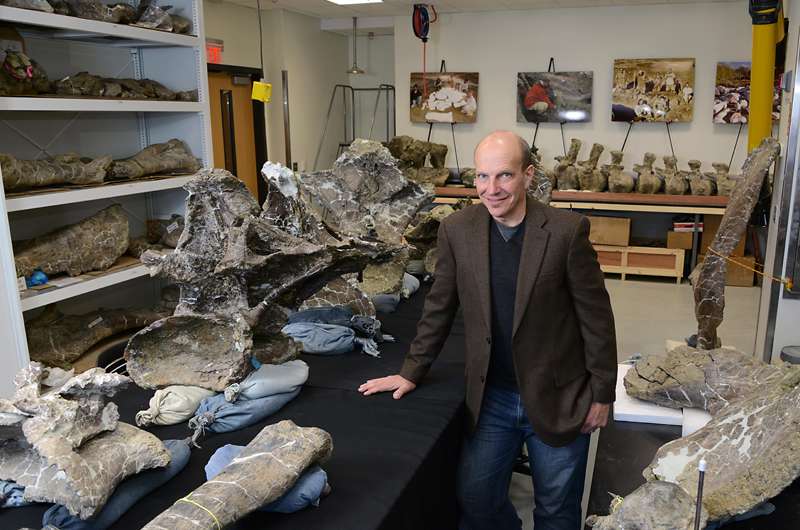
Valentina Feldman, a recent Master’s graduate from Drexel University, is making it possible to get up close to a virtual reality dinosaur. For her PhD thesis, she created an immersive visual experience of the Dreadnoughtus – one of the largest dinosaurs to have ever existed in the world.
When a visitor enters the immersive exhibit, hosted by the Academy of Natural Sciences of Drexel University, a visual filmed as a 360 degree shot featuring Kenneth Lacovara, renowned paleontologist, provides an introduction.
As he speaks, informative graphics appear around him mid-air, making the best possible use of the 3D space. The visitor then catches their first glimpse of the dinosaur’s legs through a framed archway.
The scene then transforms into a desert where Lacovara discusses the initial discovery of the Dreadnoughtus fossils. Hundreds of bones, actual size, appear all around, and these then assemble into a dinosaur skeleton that walks around the guests in circles, putting them at the center of the situation. As Lacovara begins discussing the muscles and skin of the dinosaur, the muscles and skin appear, until the Dreadnoughtus’ full form is revealed.
Feldman initially began thinking about this project while pursuing her undergraduate degree in animation and visual effects at Drexel. As an elective, she took a paleontology class with Kenneth Lacovara, who shared information about his research on the Dreadnoughtus. At the time, researchers were creating massive sketches of the dinosaur on the fourth floor of the Papadakis Integrated Sciences Building, and Feldman saw an opportunity to use the drawings for artistic purposes.
Feldman then went on to pursue an accelerated master’s degree in digital media, also at Drexel, and actually put this idea into action, creating the virtual reality Dreadnoughtus as her master’s thesis. She and her undergraduate partner Emma were able to access three-dimensional scans of the dinosaur and talk to people who were researching the dinosaur within Drexel, ensuring that every part of the project had scientific meaning. She was also able to use cutting-edge technology, invented within the past year, to film the dinosaur in 360 degrees, in order to visualize the space and size of the dinosaur in a way that traditional 3D screen animation was unable to do.
According to Feldman, Drexel was the perfect place to develop a project like hers. She had the opportunity to work in a producer role with a team that included both students on academic terms and on co-op and who came from varied departments, both art and science related. One of her biggest goals was to ensure that everything in her project was signed off by the scientists who actually discovered the Dreadnoughtus. To her, it was important for all the facts to be correct in order to make the immersive experience a viable educational tool. It was intended as a cross-disciplinary project, that would include aspects of art and science, amalgamating the work done at the digital media department with the more traditional research oriented work done at the biology department.
Feldman says that the most rewarding aspect of the entire experience is seeing children’s reactions to the exhibit. According to her, they get incredibly immersed in the experience, trying to run to and from the dinosaur, losing themselves, but also learning new information. Initially, she planned to create an entire virtual reality ecosystem surrounding the Dreadnoughtus, including multiple dinosaurs, which both children and adults alike could fully immerse themselves in. However, this project turned out to be far too much to complete in one year, even with a large team. Although Feldman herself plans to turn her attention to other projects now, she loves the idea of her work being continued by other people, and would love to see more dinosaurs added to it.
Feldman will present at the SIGGRAPH computer graphics conference in Anaheim, California July 24-28, where attendees will be able to experience the Dreadnoughtus in a planetarium setting. A free smartphone version of the exhibit will be released Aug 25, available for all major platforms, for those who could not experience the simulation in person. Feldman is also currently working on an augmented reality project which she hopes to exhibit someday.
The virtual reality Dreadnoughtus exhibit is still running at the Academy of Natural Sciences, and Drexel University students who can provide a valid ID are eligible for free admission.

